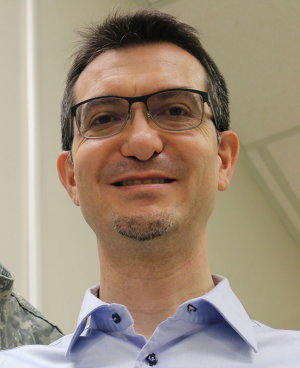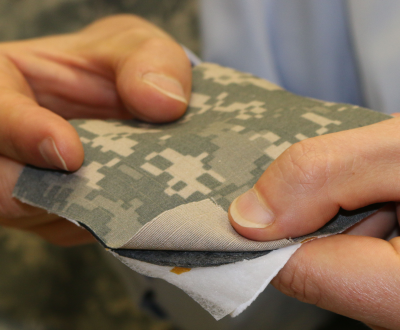Livermore scientist Francesco Fornasiero has developed a smart material that can provide breathability and protection against deadly chemical and biological threats such as Sarin and the Ebola virus.
“Our mission is to solve a long-standing problem for first responders, medical personnel, and soldiers,” says the chemical engineer, who grew up in a small town near Venice, Italy. “Since their protective clothing can’t remove water vapor fast enough, perspiration gets trapped. This makes the garments uncomfortable and too hot to wear for an extended amount of time.”
Developing a material that can wick water away from the skin and simultaneously protect against biological and chemical threats was a scientific challenge because these capabilities require that the material’s pores enable water molecules to pass through quickly, yet keep biological and chemical threats at bay.
Carbon nanotubes (CNTs)—hollow graphite cylinders with openings less than five nanometers in diameter, a width 5,000 times narrower than a human hair—provided Fornasiero with a partial solution. CNT openings are large enough for water vapor to escape, yet too small for biological threats (such as Ebola and the Dengue virus) to pass through. However, chemical threats cannot be blocked by CNTs because their molecules are much smaller than CNT openings.
Adding to the complexity of the effort was that the project sponsor (the Defense Threat Reduction Agency in the U.S. Department of Defense) was interested in a smart protective material—that is, one that could put up barriers on its own when chemical threats appeared.
The ability of the functional groups to react with nerve agents is what makes Second Skin a smart material. When the functional groups come into contact with the nerve agents, the polymeric chains collapse and block the CNT openings.
Fornasiero and his team envision that Second Skin will be incorporated into a soldier’s uniform between the outer fabric and an inner cotton liner (see photo).
“The broad spectrum of scientific expertise and resources located within the Livermore campus definitely had an impact on advancing our project,” says Fornasiero, who joined the laboratory in 2006 after receiving his Ph.D. in Chemical Engineering from the University of California, Berkeley and completing postdoctoral research at the Stanford Research Institute.
“Sometimes the tools you need are across the country and in different time zones. Here, you can try a new type of equipment right away and see if it works in your project,” he says.
The next phase in the project is to expand Second Skin’s protective properties to other chemical threats such as blister agents, and make the material stretchable (just like a sports jersey or wetsuit). After achieving those tasks, the team wants to tackle manufacturing challenges, such as producing the material at low costs and large volumes.
“What I like about working at Livermore is that I can leverage fundamental science to solve real-world problems,” says Fornasiero. “There’s an opportunity to develop materials and know-how that can be used to increase national security and personal safety.”






